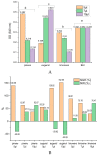Synergistic/Antagonistic Potential of Natural Preparations Based on Essential Oils Against Streptococcus mutans from the Oral Cavity
- PMID: 31703466
- PMCID: PMC6891698
- DOI: 10.3390/molecules24224043
Synergistic/Antagonistic Potential of Natural Preparations Based on Essential Oils Against Streptococcus mutans from the Oral Cavity
Abstract
The present paper addresses a thematic of interest in preventive dental medicine, namely the possibility of using essential oils (EOs) for the inhibition of the development of Streptococcus mutans (S. mutans) in the oral cavity, as a viable alternative to chemical products with protective role in oral health. For this purpose, four EOs (cinnamon, clove, bergamote, and orange) were chemically characterized by gas chromatography coupled with mass spectrometry (GC-MS) and in vitro tested against S. mutans (ATCC 25175). The results obtained revealed the antibacterial effect on S. mutans exercised by the essential oils of clove (CLEO), bergamote (BEO), and orange (OEO), which were included in the production of natural emulsion-type preparations with application in dental medicine. In order to highlight the synersistic/antagonistic effects generated by the chemical constituent of essential oils, binary and tertiary emulsions were prepared and used in saliva-enhanced medium against S. mutans. The saliva tests proved the synergistic effect exercised by the active components of EOs tested from tertiary emulsions, which cause an inhibition of the development of S. mutans in oral cavities.
Keywords: bergamot essential oil; cloves essential oil; gas chromatography-mass spectrometry (GC-MS); orange essential oil.
Conflict of interest statement
The authors declare no conflict of interest.
Figures








References
-
- Friedman J.Y. The Role of S. mutans in the Formation of Dental Caries: An Ecological Perspective. Sci. J. Lander Coll. Arts Sci. 2011;5:5.
-
- Murray P., Rosenthal K., Pfaller M. Medical Microbiology. 8th ed. Elsevier; Amsterdam, The Netherlands: 2015.
MeSH terms
Substances
LinkOut - more resources
Full Text Sources
Medical
Molecular Biology Databases
Miscellaneous

